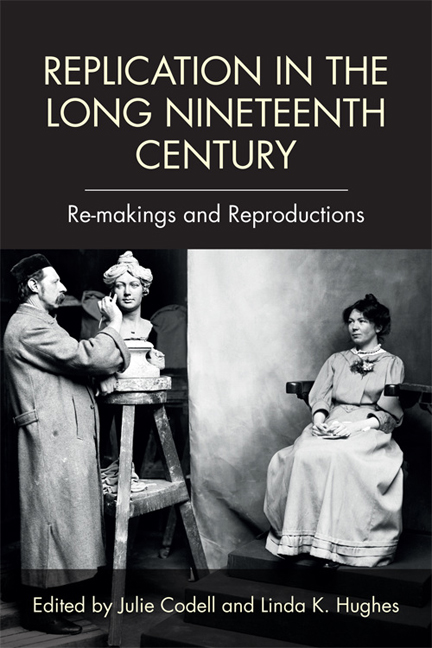Book contents
- Frontmatter
- Contents
- List of Illustrations
- Acknowledgments
- 1 Introduction: Replication in the Long Nineteenth Century – Re-makings and Reproductions
- I Replication and Networks
- II Replication and Technology
- III Replication and Authenticity
- 10 Literary Replication and the Making of a Scientific “Fact”: Richard Owen's Discovery of the Dinornis
- 11 Copying from Nature: Biological Replication and Fraudulent Imposture in Grant Allen's An African Millionaire
- 12 The Failure of Replication in Nineteenth-Century Literature: Why It All Just Comes Out Wrong
- IV Replication and Time
- Notes on Contributors
- Index
11 - Copying from Nature: Biological Replication and Fraudulent Imposture in Grant Allen's An African Millionaire
from III - Replication and Authenticity
Published online by Cambridge University Press: 11 August 2018
- Frontmatter
- Contents
- List of Illustrations
- Acknowledgments
- 1 Introduction: Replication in the Long Nineteenth Century – Re-makings and Reproductions
- I Replication and Networks
- II Replication and Technology
- III Replication and Authenticity
- 10 Literary Replication and the Making of a Scientific “Fact”: Richard Owen's Discovery of the Dinornis
- 11 Copying from Nature: Biological Replication and Fraudulent Imposture in Grant Allen's An African Millionaire
- 12 The Failure of Replication in Nineteenth-Century Literature: Why It All Just Comes Out Wrong
- IV Replication and Time
- Notes on Contributors
- Index
Summary
In his insightful study of “the copy” in Western culture, Hillel Schwartz observes that “The more adroit we are at carbon copies, the more confused we are about the unique, the original, the Real McCoy” (11). Although the original might exist theoretically, reproductions are liable to become so precise that we lose the ability to discriminate between original and copy. This vertiginous confusion is reflected in Grant Allen's detective novel An African Millionaire (1896) when a sting is organized to catch a shape-shifting conman known as Colonel Clay. The mining magnate Sir Charles Vandrift and his secretary Wentworth, who narrates the tale, have been defrauded several times by Clay. After meeting a suspicious art dealer named Dr. Polperro, however, who offers to sell them a portrait by Rembrandt, Vandrift and Wentworth believe they have finally seen through one of Clay's disguises. Having been scammed by Clay with similar offers in the past, Vandrift employs an expert to assess the painting's authenticity. The expert duly reports that the painting is, in Wentworth's words,
not a Rembrandt at all, but a cunningly-painted and well-begrimed modern Dutch imitation. Moreover, he showed us by documentary evidence that the real portrait of Maria Vanrenen had, as a matter of fact, been brought to England five years before, and sold to Sir J. H. Tomlinson, the well-known connoisseur, for eight thousand pounds. Dr. Polperro's picture was, therefore, at best either a replica by Rembrandt; or else, more probably, a copy by a pupil; or, most likely of all, a mere modern forgery. (70)
Convinced that they have the elusive Clay in their grasp, Vandrift and Wentworth arrange to buy the painting and have Polperro arrested for fraud at the moment of the transaction. Hearing that a real art dealer named Dr. Polperro exists, they assume that Clay has stolen the man's identity. The would-be detectives are, however, grossly mistaken. Their case falls apart in court as the man they arrested is revealed to be the real Polperro, his picture a genuine Rembrandt, and the supposed original bought by Tomlinson a different painting sold under false pretenses. The “expert” who claimed to have exposed the inauthenticity of Polperro's picture, Wentworth explains, “turned out to be an ignorant, self-sufficient quack” (76).
- Type
- Chapter
- Information
- Replication in the Long Nineteenth CenturyRe-makings and Reproductions, pp. 195 - 212Publisher: Edinburgh University PressPrint publication year: 2017



